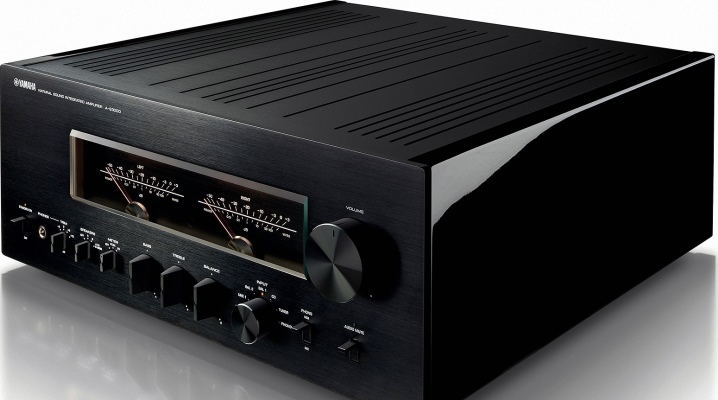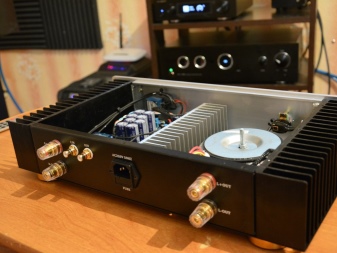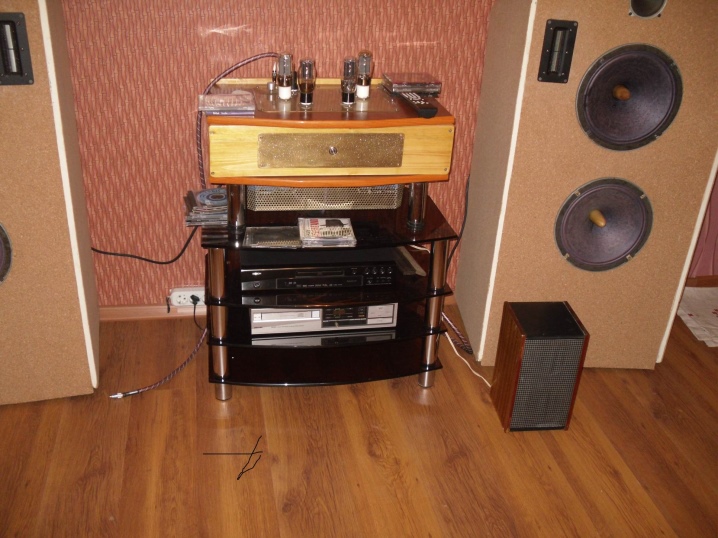Sound amplifiers for home acoustics

The amplifier is an integral part of home sound reproducing equipment. They are used to amplify low-power devices to reproduce and achieve the characteristics of an audio signal. There are also sound reproducing devices with integrated power amplifiers, but very often their technical characteristics and functionality do not meet all the requirements.
Therefore, most connoisseurs of high-quality sound often resort to purchasing an external amplifier that best suits their needs. In this publication we will try to figure out which device to choose.


Requirements
The task of the main amplifying device is to generate a signal of the required power and transfer it to the load circuit, which can contain a variety of accessories, performing the function of sound reproduction:
- acoustic systems,
- headphones,
- wire broadcasting network,
- modulator system and more.


Household amplifying devices for their key purpose assume a low level of sound amplification with the least distortion.
Such devices are usually used for home sound reproduction systems, the main condition of which is the sound quality, not its volume.

Species overview
Acoustic systems have various parameters and areas of use, in this regard, the amplifying device has a number of types. By power, there are:
- preliminary, which are a transitional link;
- terminal, directly increasing power;
- integral, connecting both previous modifications into a single device.



According to the elemental basis, they are divided into:
- lamp;
- transistor;
- integral platforms.



By the number of connected channels, the devices are divided into:
- single-channel devices;
- two-channel device;
- four-channel;
- multichannel amplification devices.


An important aspect of the classification is the scope of use of the device:
- car audio amplifier;
- home audio systems;
- concert equipment;
- studio equipment.


Rating of the best models
Let's consider certain models, let's talk about the characteristics of devices, their advantages and disadvantages. Choosing an amplifier is not an easy task considering the number of brands and modifications. Our top includes both expensive samples and budget options.
Yamaha A-S201
Yamaha is considered one of the best brands in the multimedia equipment industry. As a pioneer in audio technology, the company has grown into a global giant, becoming a favorite in the manufacture of recording equipment. At the same time, the company never ceases to amaze, constantly develops and produces innovative new items, one of which is the Yamaha A-S201 amplification device. If you have decided to purchase an amplifier, then it should be borne in mind that the Yamaha A-S201 is one of the best of its kind. It has a solid construction, has a wonderful sound, a great vinyl sound converter (phono stage).
Among the advantages: the power of the device is 100 watts per channel. Along with this, among the positive qualities should be noted the volume of the sound, even with a complicated design of musical works, the availability of a practical guide, a remote control and batteries when purchasing the device.
The disadvantages include the lack of optical, coaxial audio outputs.


SMSL SA-36A Plus
On the positive side: the audio amplifier supports Bluetooth with the ability to connect other audio devices via wireless data transmission, the presence of a class D amplifier for speaker systems, detailed sound, aluminum housing, versatility and compactness. The range is up to 10 meters.
Cons: few entrances.



TPA3116 LM1036 (2.0)
Positive: Reliable, inexpensive amplification device. The device belongs to quality devices... It has a high level of efficiency (up to 90%). Along with this, there is no need for additional cooling systems. The manufacturer has equipped the device with protection against excessive heating, excess electric current and short circuits. The device board meets all the requirements for class D amplification devices.
Cons: Power ranges from 10 to 15 watts. The installation is suitable for home use. If you are on a limited budget, you can purchase an amplifier of this class.

Pioneer A-10-K
Advantages: original design, symmetrical structure, refined technical consistency. This device comes as a kind of hi-fi device that combines elegance and simplicity. With an impeccable 10 kHz sound and playback range, you can listen to any format - from music to sound effects in movies. Made of aluminum. Power consumption is 135 watts.
Cons: insufficiently good sounding with interference, the volume is increased by software. The unit is suitable for connection to a home theater.


Dynavox CS-PA1
If you have decided to purchase a device to amplify this brand, then you need to learn about her outstanding qualities: the device is not very large in size, equipped with a function with a 3D sound effect, which makes it possible to supplement the stereo base and sound amplification. The sound amplitude of this device is at an excellent level, despite the affordable price of the device. Power for rooms of 20 square meters reaches 10-20 watts per channel.
Cons: high price. Suitable for home use.


Criterias of choice
Choosing a suitable amplifier for an apartment on your own, which meets today's requirements and meets individual wishes, is a difficult task. To some extent, this is even an engineering and technical task. It is necessary to take into account the parameters of the player and speaker systems that will be used in conjunction with the amplifier. And also additionally calculate the size and acoustics of the room where the musical equipment will be located and work. And to top it all off, you need to decide on the costs, having considered the quality bar that is acceptable for yourself.

There are several important points to keep in mind.
- First of all, it is necessary to assess the level of transient (linear) and intermodulation (nonlinear) distortions. Manufacturers do not indicate these values very often, and their presence in the passport indicates a thorough approach to business. For the best samples, the second value is not higher than 1%. Home installations have a satisfactory indicator of no more than 3%.
- When playing music, the speaker membranes vibrate erratically. They are also called parasitic. The amplification device is capable of counteracting them. The success of this is assessed by smoothing - another numerical parameter, which for domestic use should be at least 100.
- Signal to noise ratio. This is when you set the volume control of the device to a limit and compare the amount of interference with the difference in the limits of the output wanted signal. The higher the number, the clearer the sound will be.
- Frequency range... The more extensive it is, the better. It is especially good when this range goes into the zone that is not picked up by the human ear - this ensures work without interference in the audible. Of course, all other things being equal.
- It is imperative to take into account the impedance and sensitivity of the speakers with which the amplifier will need to function. Loudspeakers with low sensitivity require a more powerful device. A lower acoustic impedance than that calculated for the amplification device is able to provoke a short circuit and breakdown of the entire audio system. More, although not dangerous, with a significant difference can turn down the volume of the music being played.
- In the question of the number of playback channels, consider how many speakers you want to connect to the amplifier and in what way. Most of the amplifiers are 2-channel, it is possible to connect two speakers to them in mono or stereo mode. There are 4-channel samples, and in some - the number of channels can be up to 8. Multichannel models allow you to connect additional speakers to one amplifier. For example, a subwoofer is connected to a 4-channel. However, such amplifiers are more expensive than ordinary 2-channel amplifiers with equal power due to their more complex design.


And a few more additional recommendations.
- The selection of an amplifier modification does not always come down to its price and brand.... Nevertheless, acquiring an overly inexpensive brand is also irrational - no need to rely on a miracle.
- Purchase the device at retail outlets where it cannot be tested, it is possible only by first deciding on the selection of its modification.
- It is necessary to choose a device for amplification with a power reserve, so as not to "squeeze all the juices" with a resource close to the limit, as this instantly reduces its reliability. For example, a device with a maximum resource of 100 W guarantees long-term and reliable operation only at approximately 2 times less power.
- In addition, you should focus on the size of the area where the sound-producing equipment will be used.... The approximate power of each of the channels is 3-5 W / m2. When the space is not more than 15 m2, then it is necessary to be guided by the first number, and if the space is more than 20 m2 - the second.
- It is necessary to choose a device for amplification, in which the speaker connection is carried out not by means of spring latches, but with threaded terminals. This is the strongest fixation of the cords, moreover, this is some kind of indicator of the quality and involvement of the device in the Hi-Fi category.


In conclusion. It is not necessary to purchase the most modern modification. Sometimes a device that has been on a shelf or warehouse for a long time becomes much cheaper without degrading its performance.
For a video review of the Yamaha A-S201 amplifier, see below.













The comment was sent successfully.